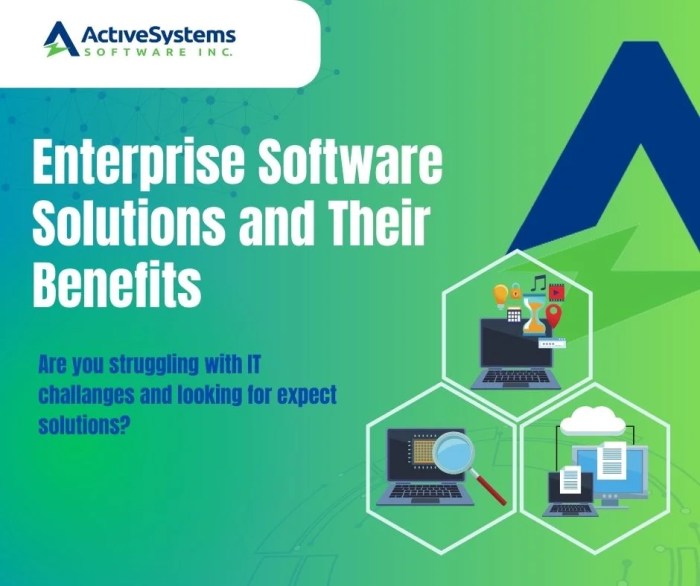Delve into the world of Enterprise Solutions Powered by Computer Information Systems, where technology and business processes intersect to drive innovation and efficiency. This captivating topic sheds light on how Computer Information Systems revolutionize the way enterprises operate, making informed decisions and optimizing resources.
Overview of Computer Information Systems in Enterprise Solutions
Computer Information Systems (CIS) refer to the use of technology to manage and analyze information in an organizational setting. In the context of enterprise solutions, CIS play a crucial role in optimizing business processes, enhancing decision-making, and improving overall efficiency.
Role of CIS in Optimizing Business Processes
- CIS streamline operations by automating repetitive tasks and workflows.
- Integration of CIS allows for real-time data sharing across departments, improving communication and collaboration.
- Analytics tools within CIS help identify bottlenecks and inefficiencies, enabling organizations to make data-driven decisions for process improvement.
Enhancing Decision-Making within Enterprises
- CIS provide access to accurate and up-to-date information, enabling management to make informed decisions quickly.
- Decision support systems integrated into CIS offer predictive modeling and scenario analysis for strategic planning.
- Business intelligence tools within CIS help in generating reports and visualizations that aid in understanding trends and patterns for decision-making.
Benefits of Implementing Enterprise Solutions Powered by CIS
Implementing Enterprise Solutions powered by Computer Information Systems (CIS) offers a wide range of benefits that can significantly enhance the efficiency and effectiveness of business operations. By leveraging CIS, organizations can streamline processes, improve decision-making, and optimize resource allocation.
Improved Operational Efficiency
- Automation of Routine Tasks: CIS can automate repetitive tasks such as data entry, processing, and reporting, allowing employees to focus on more strategic activities.
- Enhanced Collaboration: CIS facilitates seamless communication and collaboration among different departments and teams, leading to faster decision-making and problem-solving.
- Real-Time Data Insights: CIS enables real-time access to critical business data, empowering managers to make informed decisions quickly based on up-to-date information.
Cost Savings and Resource Optimization
- Reduced Operational Costs: By streamlining processes and improving efficiency, CIS helps organizations reduce operational costs associated with manual labor, errors, and delays.
- Optimized Resource Allocation: CIS provides insights into resource utilization and performance, allowing businesses to allocate resources more effectively and avoid unnecessary expenses.
- Scalability and Flexibility: CIS solutions can scale according to business needs, ensuring that resources are utilized efficiently and cost-effectively as the organization grows.
Key Components of Enterprise Solutions Powered by CIS

In order to understand how Enterprise Solutions powered by Computer Information Systems (CIS) function, it is essential to identify the key components that make up the system and how they work together to support business operations.
Data Management System
- The data management system is a crucial component of CIS that handles the storage, retrieval, and organization of data within the enterprise.
- It ensures that data is securely stored and readily accessible to users when needed, facilitating efficient decision-making processes.
- By maintaining data integrity and consistency, the data management system plays a vital role in ensuring the accuracy of information used in various business processes.
Business Intelligence Tools
- Business intelligence tools within CIS analyze and interpret data to provide valuable insights that drive strategic decision-making within the organization.
- These tools help in identifying trends, patterns, and opportunities from the data collected, enabling businesses to optimize their operations and enhance performance.
- By generating reports, dashboards, and visualizations, business intelligence tools enable stakeholders to understand complex data in a simplified manner.
Customer Relationship Management (CRM) System
- The CRM system is responsible for managing interactions with customers, tracking customer data, and improving customer relationships.
- It centralizes customer information, allowing businesses to personalize interactions, provide better customer service, and enhance customer satisfaction.
- By integrating with other components of CIS, the CRM system enables businesses to streamline sales, marketing, and customer support processes.
Implementation Strategies for CIS in Enterprise Solutions

Implementing Computer Information Systems (CIS) into enterprise solutions requires careful planning and execution to ensure seamless integration and optimal performance.
Best Practices for Integrating CIS into Existing Enterprise Systems
- Assess current system architecture and identify areas where CIS can add value.
- Develop a comprehensive integration plan that Artikels goals, timelines, and resource requirements.
- Collaborate with key stakeholders to ensure buy-in and support throughout the implementation process.
- Conduct thorough testing and quality assurance to minimize disruption to existing operations.
- Provide training and support to end-users to facilitate adoption and maximize the benefits of CIS.
Steps Involved in Deploying CIS for Seamless Operation
- Define clear objectives and key performance indicators (KPIs) to measure the success of CIS deployment.
- Select a reliable CIS solution that aligns with the organization's needs and goals.
- Customize the CIS platform to fit the specific requirements of the enterprise and ensure compatibility with existing systems.
- Gradually roll out CIS modules in phases to minimize disruption and allow for feedback and adjustments.
- Maintain ongoing support and monitoring to address any issues or optimize CIS performance over time.
Challenges and Considerations When Implementing CIS in Enterprise Solutions
- Resistance to change from employees accustomed to existing systems and processes.
- Data security and privacy concerns when integrating CIS with sensitive information.
- Technical complexities and potential system conflicts during the integration process.
- Budget constraints and resource limitations that may impact the scope and timeline of CIS implementation.
- Ensuring scalability and flexibility to accommodate future growth and evolving business needs.
Security Measures in Enterprise Solutions Powered by CIS
Ensuring robust cybersecurity measures within Computer Information Systems (CIS) is paramount for safeguarding enterprise solutions against cyber threats. By implementing stringent security protocols, organizations can protect sensitive data, maintain privacy, and mitigate risks effectively.
Importance of Cybersecurity in CIS for Enterprise Solutions
Implementing cybersecurity measures in CIS is crucial to prevent unauthorized access, data breaches, and cyber attacks that could compromise the integrity of enterprise solutions. By prioritizing cybersecurity, organizations can maintain trust with customers, comply with regulations, and safeguard their reputation.
Ensuring Data Protection and Privacy within CIS
- Encrypting sensitive data: Utilize encryption techniques to secure data both in transit and at rest, ensuring that only authorized users can access and decipher information.
- Implementing access controls: Establish strict access controls to limit user permissions based on roles and responsibilities, reducing the risk of unauthorized data access.
- Regular security audits: Conduct routine security audits to identify vulnerabilities, assess risks, and implement necessary patches or updates to enhance data protection.
Strategies for Mitigating Cybersecurity Risks in Enterprise CIS Applications
- Employee training and awareness: Educate employees on cybersecurity best practices, phishing scams, and social engineering tactics to empower them to recognize and report potential security threats.
- Implementing multi-factor authentication: Enforce multi-factor authentication for accessing critical systems and sensitive data, adding an extra layer of security beyond passwords.
- Monitoring and incident response: Deploy monitoring tools to detect suspicious activities and anomalies in real-time, coupled with a robust incident response plan to address and mitigate cybersecurity incidents promptly.
Wrap-Up

In conclusion, Enterprise Solutions Powered by Computer Information Systems offer a strategic advantage to businesses seeking to streamline operations, enhance decision-making, and bolster security measures. This in-depth discussion highlights the critical role of CIS in modern business landscapes, paving the way for future advancements and success.
Questions Often Asked
How does CIS contribute to cost savings in enterprises?
CIS helps streamline processes, identify bottlenecks, and optimize resource allocation, leading to reduced operational costs.
What are the key components of CIS in enterprise solutions?
The essential components include hardware, software, databases, networks, and people working together to support business operations.
How can enterprises ensure data protection within CIS?
Implementing encryption protocols, regular security audits, and access controls are crucial in maintaining data privacy and protection within CIS.


